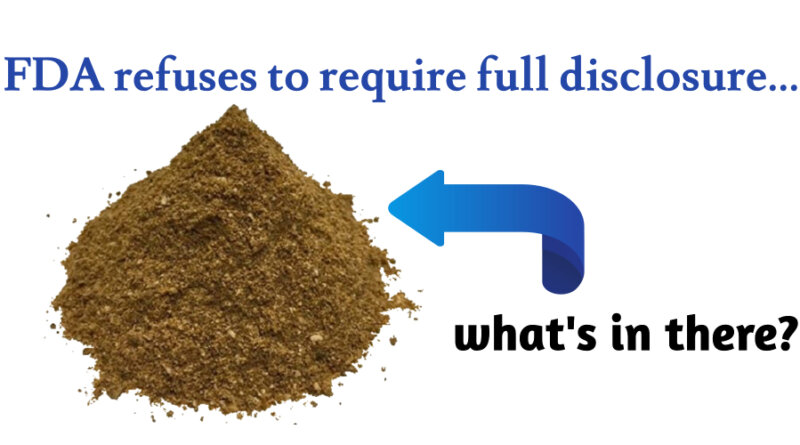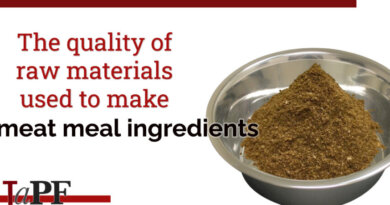(Almost) Everything About Rendered Pet Food Ingredients – Truth about Pet Food
The pet food industry states rendered ingredients “make up 40% to 60% of most finished kibble formulations for cats and dogs.” Rendered pet food ingredients are listed on labels as ‘meal’ animal protein ingredients such as Chicken Meal or Lamb Meal. Fats such as Chicken Fat are also rendered ingredients.
What is rendering?
In the April 1, 2021 Federal Register (US government website that contains government agency rules, proposed rules, and public notices), the FDA defined rendering/a renderer as:
“any firm or individual that processes slaughter byproducts; animals unfit for human consumption, including carcasses of dead cattle; or meat scraps.”
A 2004 Congressional Research Services document (prepared for the 108th Congress) describes the rendering process as:
“In most systems, raw materials are ground to a uniform size and placed in continuous cookers or in batch cookers, which evaporate moisture and free fat from protein and bone. A series of conveyers, presses, and a centrifuge continue the process of separating fat from solids.”
There are two different types of rendering facilities; integrated and independent.
Integrated Rendering.
Integrated rendering facilities are part of/integrated with USDA slaughter facilities. Integrated rendering facilities produce both edible and inedible products. ‘Edible’ indicates approved for human consumption, required to be processed under USDA inspection. ‘Inedible’ is “is defined by regulation as adulterated, uninspected, or not intended for use as human food.”
The edible and inedible rendering is performed in two distinct areas of integrated rendering facilities; “inedible and edible rendering processes are segregated.” All edible rendering “must come from USDA inspected and passed carcasses.”
Integrated rendering edible products.
The USDA states: “Integrated rendering plants may produce edible fats and proteins that are often used in the manufacture of gelatins or cosmetics if they conform to Food and Drug Administration (FDA) processing standards.”
Integrated rendering inedible products.
Integrated rendering facilities “also render inedible byproducts (including slaughter floor waste) into fats and proteins for animal feeds and for other ingredients.”
Based on the definition of inedible, the ingredients processed into animal feed/pet food through inedible rendering includes inspected and passed carcass parts (“not intended for use as human food”) and diseased/condemned carcass parts (“adulterated”). The inspected and passed carcass parts and the condemned carcass parts are not segregated and are not rendered separately. The inedible rendered ingredients are not produced under USDA inspection.
Independent Rendering.
“These plants usually collect material from other sites using specially designed trucks. They pick up and process fat and bone trimmings, inedible meat scraps, blood, feathers, and dead animals from meat and poultry slaughterhouses and processors (usually smaller ones without their own rendering operations), farms, ranches, feedlots, animal shelters, restaurants, butchers, and markets.”
No ingredients from independent rendering would be considered edible/human grade.
The Bad News.
Pet food manufacturers are not required to disclose if ingredients are processed through integrated rendering or through independent rendering. Pet owners are not informed if rendered ingredients in their pet’s food are sourced from USDA inspected and passed carcasses or adulterated carcasses (or a combination of both).
Pet owners are not informed what percentage of a rendered ingredient is meat, what percentage is bone, organs, skin, and so on. The AAFCO definitions of rendered pet food ingredients do not require the ingredient to maintain a minimum level of meat or maximum level of bone. The make-up of rendered ingredients are entirely at the discretion of the ingredient supplier.
And…the FDA refuses to require pet food labels to disclose to consumers the quality of ingredients. (Feel free to email the FDA asking them why pet food consumers continue to be denied transparency in pet food. AskCVM@fda.hhs.gov)
If your pet’s food contains a rendered ingredient, ask the manufacturer:
- Are the rendered ingredients sourced from an integrated renderer or an independent renderer?
- If from an integrated renderer, can you assure me the rendered ingredients are from edible rendering processed under USDA inspection?
- What percentage of the meal ingredient is meat? bone? organs?
Wishing you and your pet the best –
Susan Thixton
Pet Food Safety Advocate
TruthaboutPetFood.com
Association for Truth in Pet Food

Become a member of our pet food consumer Association. Association for Truth in Pet Food is a a stakeholder organization representing the voice of pet food consumers at AAFCO and with FDA. Your membership helps representatives attend meetings and voice consumer concerns with regulatory authorities. Click Here to learn more.
What’s in Your Pet’s Food?
Is your dog or cat eating risk ingredients? Chinese imports? Petsumer Report tells the ‘rest of the story’ on over 5,000 cat foods, dog foods, and pet treats. 30 Day Satisfaction Guarantee. Click Here to preview Petsumer Report. www.PetsumerReport.com
Find Healthy Pet Foods in Your Area Click Here

The 2022 List
Susan’s List of trusted pet foods. Click Here to learn more.




